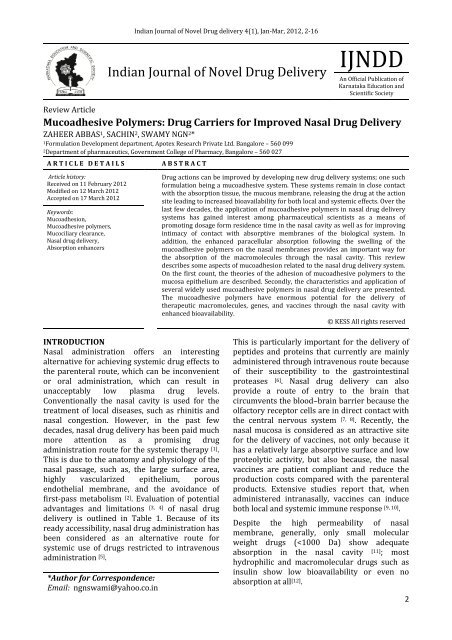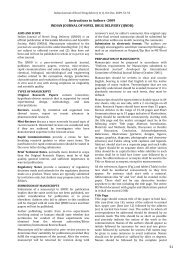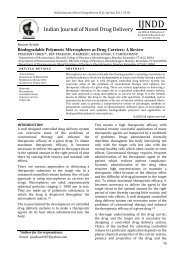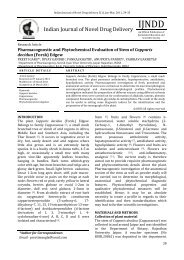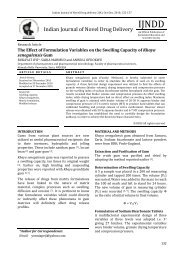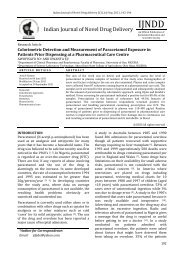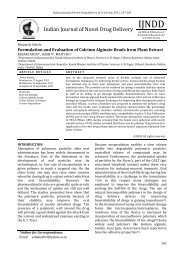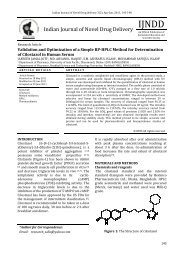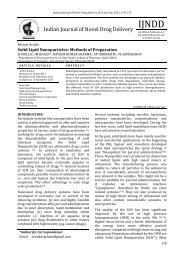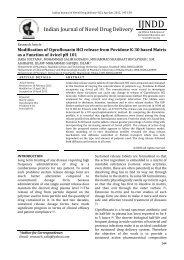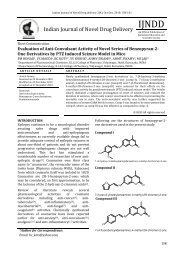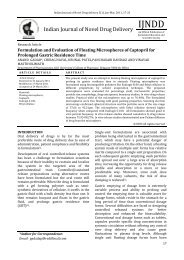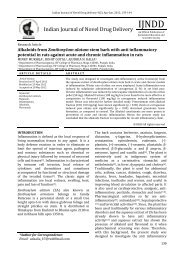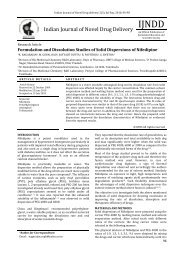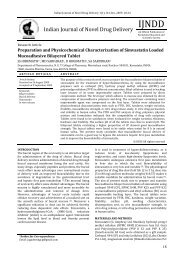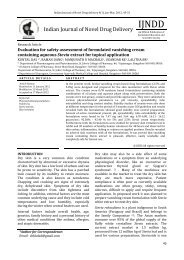Mucoadhesive Polymers - Indian Journal of Novel Drug Delivery
Mucoadhesive Polymers - Indian Journal of Novel Drug Delivery
Mucoadhesive Polymers - Indian Journal of Novel Drug Delivery
You also want an ePaper? Increase the reach of your titles
YUMPU automatically turns print PDFs into web optimized ePapers that Google loves.
<strong>Indian</strong> <strong>Journal</strong> <strong>of</strong> <strong>Novel</strong> <strong>Drug</strong> delivery 4(1), Jan-Mar, 2012, 2-16<br />
<strong>Indian</strong> <strong>Journal</strong> <strong>of</strong> <strong>Novel</strong> <strong>Drug</strong> <strong>Delivery</strong><br />
IJNDD<br />
An Official Publication <strong>of</strong><br />
Karnataka Education and<br />
Scientific Society<br />
Review Article<br />
<strong>Mucoadhesive</strong> <strong>Polymers</strong>: <strong>Drug</strong> Carriers for Improved Nasal <strong>Drug</strong> <strong>Delivery</strong><br />
ZAHEER ABBAS 1 , SACHIN 2 , SWAMY NGN 2 *<br />
1Formulation Development department, Apotex Research Private Ltd. Bangalore – 560 099<br />
2Department <strong>of</strong> pharmaceutics, Government College <strong>of</strong> Pharmacy, Bangalore – 560 027<br />
A R T I C L E D E T A I L S<br />
Article history:<br />
Received on 11 February 2012<br />
Modified on 12 March 2012<br />
Accepted on 17 March 2012<br />
Keywords:<br />
Mucoadhesion,<br />
<strong>Mucoadhesive</strong> polymers,<br />
Mucociliary clearance,<br />
Nasal drug delivery,<br />
Absorption enhancers<br />
A B S T R A C T<br />
<strong>Drug</strong> actions can be improved by developing new drug delivery systems; one such<br />
formulation being a mucoadhesive system. These systems remain in close contact<br />
with the absorption tissue, the mucous membrane, releasing the drug at the action<br />
site leading to increased bioavailability for both local and systemic effects. Over the<br />
last few decades, the application <strong>of</strong> mucoadhesive polymers in nasal drug delivery<br />
systems has gained interest among pharmaceutical scientists as a means <strong>of</strong><br />
promoting dosage form residence time in the nasal cavity as well as for improving<br />
intimacy <strong>of</strong> contact with absorptive membranes <strong>of</strong> the biological system. In<br />
addition, the enhanced paracellular absorption following the swelling <strong>of</strong> the<br />
mucoadhesive polymers on the nasal membranes provides an important way for<br />
the absorption <strong>of</strong> the macromolecules through the nasal cavity. This review<br />
describes some aspects <strong>of</strong> mucoadhesion related to the nasal drug delivery system.<br />
On the first count, the theories <strong>of</strong> the adhesion <strong>of</strong> mucoadhesive polymers to the<br />
mucosa epithelium are described. Secondly, the characteristics and application <strong>of</strong><br />
several widely used mucoadhesive polymers in nasal drug delivery are presented.<br />
The mucoadhesive polymers have enormous potential for the delivery <strong>of</strong><br />
therapeutic macromolecules, genes, and vaccines through the nasal cavity with<br />
enhanced bioavailability.<br />
© KESS All rights reserved<br />
INTRODUCTION<br />
Nasal administration <strong>of</strong>fers an interesting<br />
alternative for achieving systemic drug effects to<br />
the parenteral route, which can be inconvenient<br />
or oral administration, which can result in<br />
unacceptably low plasma drug levels.<br />
Conventionally the nasal cavity is used for the<br />
treatment <strong>of</strong> local diseases, such as rhinitis and<br />
nasal congestion. However, in the past few<br />
decades, nasal drug delivery has been paid much<br />
more attention as a promising drug<br />
administration route for the systemic therapy [1] .<br />
This is due to the anatomy and physiology <strong>of</strong> the<br />
nasal passage, such as, the large surface area,<br />
highly vascularized epithelium, porous<br />
endothelial membrane, and the avoidance <strong>of</strong><br />
first-pass metabolism [2] . Evaluation <strong>of</strong> potential<br />
advantages and limitations [3, 4] <strong>of</strong> nasal drug<br />
delivery is outlined in Table 1. Because <strong>of</strong> its<br />
ready accessibility, nasal drug administration has<br />
been considered as an alternative route for<br />
systemic use <strong>of</strong> drugs restricted to intravenous<br />
administration [5] .<br />
*Author for Correspondence:<br />
Email: ngnswami@yahoo.co.in<br />
This is particularly important for the delivery <strong>of</strong><br />
peptides and proteins that currently are mainly<br />
administered through intravenous route because<br />
<strong>of</strong> their susceptibility to the gastrointestinal<br />
proteases [6]. Nasal drug delivery can also<br />
provide a route <strong>of</strong> entry to the brain that<br />
circumvents the blood–brain barrier because the<br />
olfactory receptor cells are in direct contact with<br />
the central nervous system [7, 8] . Recently, the<br />
nasal mucosa is considered as an attractive site<br />
for the delivery <strong>of</strong> vaccines, not only because it<br />
has a relatively large absorptive surface and low<br />
proteolytic activity, but also because, the nasal<br />
vaccines are patient compliant and reduce the<br />
production costs compared with the parenteral<br />
products. Extensive studies report that, when<br />
administered intranasally, vaccines can induce<br />
both local and systemic immune response [9, 10] .<br />
Despite the high permeability <strong>of</strong> nasal<br />
membrane, generally, only small molecular<br />
weight drugs (
Swamy NGN et al / <strong>Indian</strong> <strong>Journal</strong> <strong>of</strong> <strong>Novel</strong> <strong>Drug</strong> <strong>Delivery</strong> 4(1), Jan-Mar, 2012, 2-16<br />
Table 1: Potential advantages and limitations <strong>of</strong> nasal drug delivery<br />
Advantages<br />
• Avoids degradation <strong>of</strong> drug in gastrointestinal tract<br />
resulting from acidic or enzymatic degradation<br />
• Avoids degradation <strong>of</strong> drug resulting from hepatic<br />
first-pass metabolism<br />
• Results in rapid absorption and onset <strong>of</strong> action<br />
• Results in higher bioavailability thus needing lower<br />
doses <strong>of</strong> drug<br />
• Easily accessible, non-invasive route<br />
• Self-medication is possible through this route<br />
• Direct transport into systemic circulation and CNS is<br />
possible<br />
• Offers lower risk <strong>of</strong> overdose<br />
• Does not have any complex formulation requirement<br />
The main reason for this is that they are lowly<br />
permeable and susceptible to the proteases in<br />
the nasal mucosal membrane, so these drugs can<br />
be rapidly cleared from the cavity, by ciliary<br />
movement or enzymatic degradation before they<br />
reach the bloodstream, and cannot cross the<br />
mucosal barriers [13] . Penetration enhancers such<br />
as surfactants [14], bile salts [15,16], fusidate<br />
derivatives [17] , and phospholipids [18] have been<br />
used to improve the drug absorption through<br />
nasal mucosa, but toxicity tests have proved that<br />
they were <strong>of</strong> limited clinical use because <strong>of</strong> their<br />
irreversible damage to nasal mucosa<br />
accompanied with their absorption-enhancing<br />
effects [19] .<br />
Some mucoadhesive polymers, such as cellulose,<br />
polyacrylate, starch, and chitosan, have proven to<br />
be effective on improving intranasal absorption<br />
<strong>of</strong> hydrophilic macromolecules. These polymers<br />
achieve this by increasing the drug residence<br />
time in the nasal cavity or enhancing intranasal<br />
absorption; some <strong>of</strong> them can serve both the<br />
functions. Most <strong>of</strong> these polymers are generally<br />
recognized as safe (GRAS) pharmaceutical<br />
excipients and not absorbed, so they would not<br />
be expected to display systemic toxicity.<br />
Even though a number <strong>of</strong> challenges are still to<br />
be overcome, the encouraging results stimulate<br />
pharmaceutical researchers to exercise further<br />
efforts in order to develop new nasal<br />
formulations to replace the conventional<br />
parenteral products. In this article, the use <strong>of</strong><br />
mucoadhesive polymers for the intranasal<br />
delivery <strong>of</strong> drugs is reviewed. Their ability <strong>of</strong><br />
enhancing the intranasal absorption <strong>of</strong><br />
Limitations<br />
• Volume that can be delivered into nasal cavity is<br />
restricted to 25–200 µl<br />
• High molecular weight compounds cannot be delivered<br />
through this route (mass cut <strong>of</strong>f ~1 kDa)<br />
• Adversely affected by pathological conditions<br />
• Large interspecies variability is observed in this route<br />
• Normal defence mechanisms like mucociliary<br />
clearance and ciliary beating affects the permeability <strong>of</strong><br />
drug<br />
• Enzymatic barrier to permeability <strong>of</strong> drugs<br />
• Irritation <strong>of</strong> nasal mucosa by drugs<br />
• Limited understanding <strong>of</strong> mechanisms and less<br />
developed models at this stage<br />
macromolecular hydrophilic drugs will be<br />
focused on.<br />
<strong>Mucoadhesive</strong> polymers<br />
<strong>Mucoadhesive</strong> polymers [20] are water-soluble<br />
and water insoluble polymers, which are<br />
swellable networks, jointed by cross-linking<br />
agents. These polymers possess optimal polarity<br />
to make sure that they permit sufficient wetting<br />
by the mucus and optimal fluidity that permits<br />
the mutual adsorption and interpenetration <strong>of</strong><br />
polymer and mucus to take place. <strong>Mucoadhesive</strong><br />
polymers that adhere to the mucin-epithelial<br />
surface can be conveniently divided into three<br />
broad classes:<br />
1. <strong>Polymers</strong> that become sticky when placed<br />
in water and owe their mucoadhesion to<br />
stickiness.<br />
2. <strong>Polymers</strong> that adhere through nonspecific,<br />
non-covalent interactions that are<br />
primarily electrostatic in nature (although<br />
hydrogen and hydrophobic bonding may<br />
be significant).<br />
3. <strong>Polymers</strong> that bind to specific receptor site<br />
on tile self-surface.<br />
All three polymer types can be used for drug<br />
delivery<br />
Characteristics <strong>of</strong> an ideal mucoadhesive<br />
polymer [21]<br />
1. The polymer and its degradation products<br />
should be nontoxic and should be<br />
nonabsorbable from the gastrointestinal<br />
tract.<br />
2. It should be non-irritant to the mucous<br />
membrane.<br />
3
Swamy NGN et al / <strong>Indian</strong> <strong>Journal</strong> <strong>of</strong> <strong>Novel</strong> <strong>Drug</strong> <strong>Delivery</strong> 4(1), Jan-Mar, 2012, 2-16<br />
3. It should preferably form a strong noncovalent<br />
bond with the mucin-epithelial<br />
cell surfaces.<br />
4. It should adhere quickly to most tissue and<br />
should possess some site-specificity.<br />
5. It should allow incorporation to the daily<br />
dose <strong>of</strong> the drug and <strong>of</strong>fer no hindrance to<br />
its release.<br />
6. The polymer must not decompose on<br />
storage or during the shelf life <strong>of</strong> the<br />
dosage form.<br />
7. The cost <strong>of</strong> polymer should not be high so<br />
that the prepared dosage form remains<br />
competitive.<br />
Robinson and his group [22] , using the<br />
fluorescence technique, concluded that:<br />
Cationic and anionic polymers bind more<br />
effectively than neutral polymers.<br />
Polyanions are better than polycations in<br />
terms <strong>of</strong> binding/potential toxicity, and<br />
further, that water-insoluble polymers give<br />
greater flexibility in dosage form design<br />
compared with rapidly or slowly dissolving<br />
water-soluble polymers.<br />
Anionic polymers with sulfate groups bind<br />
more effectively than those with carboxylic<br />
groups.<br />
Degree <strong>of</strong> binding is proportional to the<br />
charge density on the polymer.<br />
Highly binding polymers include<br />
carboxymethyl cellulose, gelatin,<br />
hyaluronic acid, carbopol, and<br />
polycarbophil.<br />
Molecular characteristics<br />
Investigations into polymers with various<br />
molecular characteristics conducted by many<br />
authors [23] have led to a number <strong>of</strong> conclusions<br />
regarding the molecular characteristics required<br />
for mucoadhesion.<br />
The properties exhibited by a good<br />
mucoadhesive may be summarized as follows [24] :<br />
1. Strong hydrogen bonding groups (-OH, -<br />
COOH).<br />
2. Strong anionic charges.<br />
3. Sufficient flexibility to penetrate the mucus<br />
network or tissue crevices.<br />
4. Surface tension characteristics suitable for<br />
wetting mucus/mucosal tissue surface.<br />
5. High molecular weight.<br />
Although an anionic nature is preferable for a<br />
good mucoadhesive, a range <strong>of</strong> nonionic<br />
molecules (e.g., cellulose derivatives) and some<br />
cationics (e.g., Chitosan) can be successfully used.<br />
Mucoadhesion/bioadhesion<br />
In 1986, Longer et al. defined the term<br />
‘bioadhesion’ as ‘the attachment <strong>of</strong> a synthetic or<br />
biological macromolecule to mucus and/or an<br />
epithelial surface for an extended period <strong>of</strong><br />
time’ [25] . Similarly, Gu et al. described the term<br />
‘mucoadhesion’ as ‘the binding <strong>of</strong> polymers to<br />
mucin/epithelial surface’ [26]. In nasal drug<br />
delivery, mucoadhesion means the adherence <strong>of</strong><br />
a polymeric material to nasal epithelial surface<br />
(bioadhesion) or nasal mucus (mucoadhesion).<br />
Mechanism <strong>of</strong> mucoadhesion<br />
The process <strong>of</strong> mucoadhesion following nasal<br />
administration relates to the interaction between<br />
the mucoadhesive polymer and the mucus<br />
secreted by the sub-mucosal glands [27] . The<br />
sequential events that occur during the<br />
mucoadhesion include the proper wetting and<br />
swelling <strong>of</strong> the polymer, and intimate contact<br />
between the polymer and the nasal mucosa.<br />
Then, the swollen mucoadhesive polymer<br />
penetrates into the tissue crevices followed by<br />
the interpenetration between the polymer chains<br />
[28] and the protein chains <strong>of</strong> the mucus (Figure<br />
1).<br />
To obtain sufficient absorption <strong>of</strong> drugs, firstly,<br />
the formulation should spread well on the nasal<br />
mucosa. Therefore, the spreadability is very<br />
important for the liquid mucoadhesive<br />
formulation, so does the flowability and<br />
wettablility for the solid mucoadhesive<br />
formulation [29, 30] .<br />
Hydration <strong>of</strong> the polymer (swelling) plays a very<br />
important role in mucoadhesion, through which<br />
the polymer chains are liberated and interact<br />
with the biological tissue [31] . During hydration,<br />
there is a dissociation <strong>of</strong> hydrogen bonds <strong>of</strong> the<br />
polymer chains. When the polymer– water<br />
interaction becomes greater than the polymer–<br />
polymer interaction, adequate free polymer<br />
chains will be available for interaction between<br />
the polymer and the biological tissue. The<br />
Vander Waals, hydrogen, hydrophobic, and<br />
electrostatic forces between the polymer and the<br />
biological tissue (including the mucus), which<br />
form secondary chemical bonds, result in the<br />
adhesion <strong>of</strong> polymer to the mucosa [32, 33] . There is<br />
a critical degree <strong>of</strong> hydration required for<br />
optimum mucoadhesion. The incomplete<br />
hydration because <strong>of</strong> the lack <strong>of</strong> the water leads<br />
to incomplete liberation <strong>of</strong> the polymer chains.<br />
4
Swamy NGN et al / <strong>Indian</strong> <strong>Journal</strong> <strong>of</strong> <strong>Novel</strong> <strong>Drug</strong> <strong>Delivery</strong> 4(1), Jan-Mar, 2012, 2-16<br />
Figure 1: Schematic representation <strong>of</strong> the process <strong>of</strong> mucoadhesion on the nasal mucosa surface<br />
Ciliary clearance<br />
Hydrophilic macromolecular <strong>Drug</strong>s<br />
Enzymatic<br />
metabolism<br />
Intranasal absorption<br />
(A) Ordinary Intranasal delivery: A small fraction <strong>of</strong> drugs can be absorbed because <strong>of</strong> the low permeability <strong>of</strong> the hydrophilic<br />
macromolecular drugs; most <strong>of</strong> the drug will be cleared by the ciliary movement or be metabolized by the enzymes existing<br />
in the nasal cavity.<br />
<strong>Mucoadhesive</strong> Carrier<br />
Hydration and swelling <strong>of</strong> Polymer<br />
Ciliary clearance<br />
Hydrophilic macromolecular <strong>Drug</strong>s<br />
Enzymatic<br />
metabolism<br />
Intranasal absorption<br />
(B) <strong>Mucoadhesive</strong> intranasal drug delivery: the mucoadhesive carrier enhances the intranasal absorption by increasing the<br />
retention time <strong>of</strong> the drugs and promoting the paracellular absorption in the nasal cavity, whereas, the ciliary clearance is<br />
reduced. The mucoadhesive carrier can also protect the drugs from the enzymatic metabolism to a large extent.<br />
Figure 2: Schematic representation <strong>of</strong> the comparison <strong>of</strong> ordinary intranasal formulation with<br />
mucoadhesive intranasal formulation.<br />
5
Swamy NGN et al / <strong>Indian</strong> <strong>Journal</strong> <strong>of</strong> <strong>Novel</strong> <strong>Drug</strong> <strong>Delivery</strong> 4(1), Jan-Mar, 2012, 2-16<br />
On the other hand, an excessive amount <strong>of</strong> water<br />
will weaken the mucoadhesive bonds by over<br />
diluting the polymer solution [34] .<br />
The polymer chains penetrating into the tissue<br />
crevices can hold back the ciliary movement,<br />
which will increase the retention time <strong>of</strong> the<br />
drugs in the nasal cavity [35] . Furthermore, the<br />
existence <strong>of</strong> the mucoadhesive carrier also<br />
reduces the contact between the drugs and the<br />
enzymes existing in the mucosa. These both can<br />
enhance the intranasal absorption <strong>of</strong> hydrophilic<br />
drugs. The comparison <strong>of</strong> ordinary intranasal<br />
formulation (A) with mucoadhesive intranasal<br />
formulation (B) is displayed in Figure 2. Apart<br />
from these, the dehydration <strong>of</strong> the epithelial cells<br />
after hydration may also temporarily open the<br />
tight junctions between the epithelial cells and<br />
improve the paracellular absorption <strong>of</strong><br />
macromolecular drugs. The opening mechanism<br />
has been demonstrated by the decrease in ZO-1<br />
proteins and the change in the cytoskeletal<br />
protein F-actin from a filamentous to a globular<br />
structure [36] . This function <strong>of</strong> the mucoadhesive<br />
polymer is very important for the enhancement<br />
<strong>of</strong> the intranasal absorption <strong>of</strong> macromolecules<br />
weighing above 1000 Da [37] .<br />
Mucoadhesion can slow down the mucociliary<br />
clearance, but with time, mucus production will<br />
lead to the inordinate swelling <strong>of</strong> the<br />
mucoadhesive polymer and the reduction <strong>of</strong> the<br />
mucoadhesion bond strength, allowing a<br />
recovery <strong>of</strong> normal mucociliary movement rate<br />
and the clearance <strong>of</strong> the polymer from the<br />
mucosa [27] .<br />
Although many references indicate that the<br />
mucoadhesive polymer is effective in enhancing<br />
the intranasal absorption <strong>of</strong> macromolecular<br />
drugs, very few papers focus on the changes <strong>of</strong><br />
gel structure and rheology <strong>of</strong> the mucus caused<br />
by the mucoadhesive polymer and as to what<br />
extent the interaction between the polymer and<br />
the mucus influences the release <strong>of</strong> the drugs,<br />
including the diseased condition. Disease<br />
conditions can affect mucoadhesion because <strong>of</strong><br />
their influence on either mucus production or<br />
ciliary movement, and then may result in<br />
undesired drug release. Thus a good<br />
understanding <strong>of</strong> the nature <strong>of</strong> mucus in these<br />
diseases is imperative in designing a good nasal<br />
drug delivery system. <strong>Mucoadhesive</strong> capabilities<br />
<strong>of</strong> polymers should be studied under such<br />
diseased conditions during the product<br />
development.<br />
Factors that influence mucoadhesion<br />
The factors that influence mucoadhesiveness <strong>of</strong> a<br />
polymer include the type <strong>of</strong> functional groups<br />
present, polymer molecular mass, molecular<br />
mass between cross-links (cross-linking density),<br />
spatial orientation, contact time with mucus,<br />
polymer concentration, environmental pH and<br />
physiological variables like mucin turnover and<br />
diseased conditions. These will be further<br />
explained under the subheadings, namely<br />
polymer-related, environment-related and<br />
physiological related factors.<br />
Polymer-related factors<br />
The polymer molecular mass will influence its<br />
bioadhesion characteristics. There is a critical<br />
polymer molecular mass and cross-linking<br />
density below or above which there is reduced<br />
adhesive power, and this varies with the type <strong>of</strong><br />
polymer [38–40]. Mucoadhesion requires an<br />
adequate free chain length for interpenetration<br />
to occur. Reducing the free chain length by<br />
extensive cross-linking therefore reduces<br />
mucoadhesion. An optimum polymer<br />
concentration is required at the polymer–mucus<br />
interface for bioadhesion, beyond which few<br />
polymer chains will be available for polymer–<br />
mucus interpenetration. The polymer<br />
concentration that is required for optimum<br />
bioadhesion is different between gels and solid<br />
bioadhesives. In the liquid state, an optimum<br />
concentration exists for each polymer beyond<br />
that, a reduced adhesion results because fewer<br />
polymer chains will be available for<br />
interpenetration with the mucus. On the other<br />
hand, with solid dosage forms such as buccal<br />
tablets, increased polymer concentration leads to<br />
increased mucoadhesive power [41] .<br />
Environment-related factors<br />
Polymer hydration and swelling are required for<br />
initiation <strong>of</strong> mucoadhesion but excessive<br />
hydration with inordinate swelling <strong>of</strong> the<br />
polymer reduces its adhesive strength. The<br />
swelling/hydration rate should not be too rapid<br />
in order to prolong the adhesion time. On the<br />
other hand, inordinate swelling is eventually<br />
required to reduce polymer adhesiveness and to<br />
allow it to detach from the biological tissue.<br />
Some polymers owe their mucoadhesiveness to<br />
such forces as hydrogen bonding, Vander Waals,<br />
hydrophobic and electrostatic forces. The<br />
strength <strong>of</strong> these forces is influenced by the<br />
environmental pH. Consequently, for such<br />
polymers, environmental pH is a very important<br />
determinant <strong>of</strong> mucoadhesive strength. This has<br />
6
Swamy NGN et al / <strong>Indian</strong> <strong>Journal</strong> <strong>of</strong> <strong>Novel</strong> <strong>Drug</strong> <strong>Delivery</strong> 4(1), Jan-Mar, 2012, 2-16<br />
been clearly demonstrated for polycarbophil and<br />
more recently for chitosan [42] . This has also been<br />
exploited in development <strong>of</strong> pH-sensitive<br />
mucoadhesive polymers.<br />
Physiological-related factors<br />
Mucociliary clearance, mucus turnover and<br />
diseased states are physiological factors which<br />
influence nasal mucoadhesion. Mucoadhesion<br />
can slow down mucociliary clearance, but with<br />
time, mucus production reduces the<br />
mucoadhesion bond strength, allowing a<br />
recovery <strong>of</strong> mucociliary clearance to normal<br />
clearance rates, thereby removing the<br />
mucoadhesive. Diseased conditions mentioned<br />
earlier can affect mucoadhesion due to their<br />
influence on either mucus production or ciliary<br />
beating. Thus a good understanding <strong>of</strong> the nature<br />
<strong>of</strong> mucus in these diseases is imperative in<br />
designing a good nasal drug delivery system. An<br />
abnormal mucus layer could present an<br />
unanticipated barrier to drug transport through<br />
the mucosa. <strong>Mucoadhesive</strong> capabilities <strong>of</strong><br />
polymers should be studied during product<br />
development under such diseased conditions as<br />
considered relevant.<br />
<strong>Mucoadhesive</strong> polymers used in nasal drug<br />
delivery<br />
Cellulose derivatives<br />
Cellulose is a class <strong>of</strong> most available<br />
polysaccharide, consisting <strong>of</strong> 8000–10,000<br />
glucose residues linked by β-1,4glucosidic bonds.<br />
There are many pharmaceutical grade<br />
derivatives <strong>of</strong> cellulose widely used in different<br />
administration routes. Several cellulose<br />
derivatives have proved to be effective in<br />
enhancing the intranasal absorption <strong>of</strong> drugs,<br />
including soluble cellulose derivatives such as<br />
hydroxypropyl methylcellulose (HPMC),<br />
hydroxypropyl cellulose (HPC), methylcellulose<br />
(MC) and carboxymethyl cellulose (CMC), and<br />
insoluble cellulose derivatives such as<br />
ethylcellulose (EC) and microcrystalline cellulose<br />
(MCC). Table 2 summarizes the nasal drug<br />
delivery studies where the cellulose derivatives<br />
were employed as mucoadhesive carrier.<br />
Cellulose derivatives can markedly prolong the<br />
residence time <strong>of</strong> drugs in the nasal cavity<br />
because <strong>of</strong> their desirable mucoadhesive<br />
property [43] . Additionally, because <strong>of</strong> their high<br />
viscosity following hydration in the nasal cavity,<br />
the celluloses can sustain the release <strong>of</strong> drugs [44] .<br />
For these reasons using celluloses as absorption<br />
enhancers can lead to improved intranasal<br />
absorption and increased bioavailability. Many<br />
references show that the celluloses are effective<br />
in increasing the intranasal bioavailability <strong>of</strong><br />
small hydrophobic and hydrophilic<br />
macromolecular drugs (Table 2). For example,<br />
Apomorphine administered nasally with CMC,<br />
can obtain a relative bioavailability <strong>of</strong> 102%<br />
compared with subcutaneous injection in<br />
rabbits. Another study reported that an absolute<br />
bioavailability up to 90.77% could be achieved<br />
for ketorolac tromethamine administered with<br />
MCC [45] . The peptide drugs leuprolide and FD-4,<br />
when dosed with MCC/HPC through nasal route,<br />
reached an absolute bioavailability <strong>of</strong> 34.9% and<br />
35.5% in rabbits, respectively [46] .<br />
Sometimes, combination <strong>of</strong> the celluloses with<br />
other absorption enhancer would obtain better<br />
effectiveness than using the polymer alone.<br />
Ozsoy et al. have reported that the intranasal<br />
absolute bioavailability <strong>of</strong> cipr<strong>of</strong>loxacin in<br />
rabbits using MC and hydroxyethyl cellulose<br />
(HEC) alone as enhancer is only 18.2% and<br />
19.46%, respectively. When combined with<br />
Tween 80, the bioavailability increased to<br />
22.35% and 25.39%, respectively [47] . In another<br />
study by Ikeda et al. involving the intranasal<br />
delivery <strong>of</strong> dopamine, the combination <strong>of</strong> the<br />
HPC and azone led to an absolute bioavailability<br />
<strong>of</strong> almost 100% whereas it was only 25% with<br />
HPC alone [48] .<br />
Polyacrylates<br />
Polyacrylates have been investigated very<br />
frequently in many drug administration routes,<br />
such as oral [49] , ocular [50] , transdermal [51, 52] and<br />
nasal [53] drug delivery systems, because <strong>of</strong> their<br />
excellent mucoadhesive and gel-forming<br />
capability. Among the pharmaceutical<br />
polyacrylates, carbomers and polycarbophil,<br />
which differ in the cross-linking condition and<br />
viscosity, are widely used in the nasal<br />
mucoadhesive drug delivery systems [54] . Table 3<br />
summarizes the studies on the use <strong>of</strong><br />
polyacrylates in nasal drug delivery system.<br />
Polyacrylates, capable <strong>of</strong> attaching to mucosal<br />
surfaces, can <strong>of</strong>fer the prospects <strong>of</strong> prolonging<br />
the residence time <strong>of</strong> drugs at the sites <strong>of</strong> drug<br />
absorption and ensure intimate contact between<br />
the formulation and the membrane surface.<br />
Studies by Ugwoke et al. in rabbits have reported<br />
that the use <strong>of</strong> Carbopol 971P in nasal dosage<br />
forms increased the residence time in the nasal<br />
cavity. The percentage <strong>of</strong> the formulations<br />
cleared from the nasal cavity at 3 hours was 24%<br />
for Carbopol 971P, whereas it was 70% for<br />
7
Swamy NGN et al / <strong>Indian</strong> <strong>Journal</strong> <strong>of</strong> <strong>Novel</strong> <strong>Drug</strong> <strong>Delivery</strong> 4(1), Jan-Mar, 2012, 2-16<br />
lactose [55] . Sustained release <strong>of</strong> drugs can also be<br />
obtained by using polyacrylates in nasal<br />
formulation, which resulted in a more stable<br />
blood concentration–time curve. Another<br />
research by Ugwoke et al. showed that the Tmax<br />
<strong>of</strong> the Carbopol 971P-containing formulation <strong>of</strong><br />
apomorphine was 52.21 minutes, which<br />
represented a fivefold improvement compared<br />
with that <strong>of</strong> the lactose-containing formulation,<br />
whereas the Cmax <strong>of</strong> the Carbopol 971Pcontaining<br />
formulation was 330.2 ng/mL, lower<br />
than that <strong>of</strong> the lactose containing formulation,<br />
which was 450.7 ng/mL [54] .<br />
Besides the mucoadhesion capability,<br />
polyacrylates may also temporarily open the<br />
tight junctions between the epithelial cells<br />
during the swelling progress in the nasal cavity<br />
and improve the paracellular absorption <strong>of</strong> drugs<br />
[55]. Based on these, polyacrylates can increase<br />
the intranasal bioavailability <strong>of</strong> both small<br />
hydrophobic drugs and hydrophilic<br />
macromolecular drugs. Using the Carbopol 971P<br />
and polycarbophil in the nasal apomorphine<br />
formulation, a relative drug bioavailability <strong>of</strong><br />
99.8% and 105.0% could be obtained compared<br />
to subcutaneous injection [56] respectively. An<br />
absolute bioavailability <strong>of</strong> 14.4% in rabbits was<br />
reported for intranasal insulin formulation<br />
containing Carbopol 974P [57] .<br />
The Carbopol and polycarbophil are considered<br />
as generally regarded as safe (GRAS) by FDA, and<br />
many studies show that they are nonirritant to<br />
the skin and eye and nontoxic orally. Callens et<br />
al. reported that the effect <strong>of</strong> Carbopol on the<br />
mucosa is negligible and reversible, no change <strong>of</strong><br />
the epithelium barrier was observed even after a<br />
4-week administration <strong>of</strong> Carbopol-based<br />
powder formulation in rabbits [57, 58] .<br />
Starch<br />
The starch is one <strong>of</strong> the most widely used<br />
mucoadhesive carrier for nasal drug delivery,<br />
which has been reported to be effective on<br />
improving the absorption <strong>of</strong> both small<br />
hydrophobic drugs and hydrophilic<br />
macromolecular drugs (see Table 4). Maize<br />
starch is the most preferred class for<br />
pharmaceutical purpose, among which the drumdried<br />
waxy maize starch (DDWM), because <strong>of</strong> its<br />
better bioadhesive property, has been<br />
considered as the best one compared with starch<br />
processed through other methods [57] .Starch can<br />
be used as nasal drug carrier in the form <strong>of</strong><br />
powders, microspheres, or nanoparticles, among<br />
which the degradable starch microspheres<br />
(DSM), also known as Spherex®, is the most<br />
widely used and also the first example <strong>of</strong><br />
mucoadhesive Microparticulate nasal delivery<br />
system [59] . These microspheres are prepared by<br />
an emulsion polymerization technique, in which<br />
the starch is cross-linked with epichlorohydrine<br />
that can incorporate molecules weighing less<br />
than 30 kDa. Because <strong>of</strong> its mucoadhesion, the<br />
DSM can enhance the drug absorption by<br />
prolonging the residence time <strong>of</strong> drugs in the<br />
nasal cavity [60] . Illum et al. have observed that<br />
the half-life <strong>of</strong> clearance for DSM was prolonged<br />
to 240 minutes compared with 15 minutes for<br />
the liquid and powder control formulations [61] .<br />
Bjork and Edman suggested that water uptake by<br />
DSM and subsequent swelling might cause<br />
dehydration <strong>of</strong> the epithelial cells leading to the<br />
widening <strong>of</strong> tight junctions and as a consequence<br />
facilitate the paracellular transport <strong>of</strong> large<br />
hydrophilic molecules such as insulin [62] . It was<br />
suggested that the extent <strong>of</strong> drug absorption was<br />
improved even further when DSM were<br />
combined with the biological enhancers such as<br />
lysophosphatidylcholine (LPC) [63–65] . DSM can<br />
also protect the proteins wrapped in it against<br />
degradation by proteases in the mucosa. Several<br />
studies have revealed that the release <strong>of</strong> drugs<br />
from DSM was rapid and not sustained. This<br />
suggested that the utility <strong>of</strong> DSM in nasal drug<br />
delivery could further be exploited in the<br />
treatment <strong>of</strong> crisis diseases [66] . It was reported<br />
that DSM were well tolerated both in<br />
experimental animals and in humans; a test on<br />
healthy volunteers showed that only a small<br />
hyperplasia in the septum wall was observed<br />
when the DSM were administered two times per<br />
day for 8 weeks in dosages <strong>of</strong> 20 mg [67, 68] .<br />
Chitosan<br />
Chitosan [2-amino-2-deoxy-(1-4)-β-dglucopyranan]<br />
is a linear cationic polysaccharide<br />
that is obtained by a process <strong>of</strong> deacetylation<br />
from chitin, an abundant structural<br />
polysaccharide in shells <strong>of</strong> crustacean such as<br />
lobsters, shrimps, and crabs [69] . Because <strong>of</strong> the<br />
NH 2 groups resulting from the deacetylation<br />
process, chitosan is insoluble at neutral and<br />
alkaline pH. However, it can form water-soluble<br />
salts with inorganic and organic acids including<br />
glutamic acid, hydrochloric acid, lactic acid, and<br />
acetic acid. Toxicity tests have revealed that the<br />
LD50 <strong>of</strong> chitosan in mice exceeds 16 g/kg [70] .<br />
Because <strong>of</strong> its low cost, biodegradability, and<br />
biocompatibility, chitosan has been extensively<br />
used as pharmaceutical excipient in oral, ocular,<br />
nasal, implant, parenteral, and transdermal drug<br />
delivery systems [71] .<br />
8
Swamy NGN et al / <strong>Indian</strong> <strong>Journal</strong> <strong>of</strong> <strong>Novel</strong> <strong>Drug</strong> <strong>Delivery</strong> 4(1), Jan-Mar, 2012, 2-16<br />
Table 2: Summary <strong>of</strong> some nasal drug delivery studies where cellulose derivatives were employed<br />
<strong>Mucoadhesive</strong> polymer <strong>Drug</strong>s Dosage<br />
forms<br />
Abs. BA (%)<br />
Animal<br />
species<br />
Reference<br />
EC FD-4 Powder 38.0 ± 3.8 Rats 95<br />
MCC, pH 5.95 Ketorolac tromethamine Spray 90.77 Rabbits 45<br />
MCC Insulin Spray 1.9 Rabbits 96<br />
MCC Cyanocobalamine Powder 25.0 Rabbits 97<br />
MCC Glucagon Powder - Human 98<br />
MCC/HPC Leuprolide Powder 34.9 Rabbits 46<br />
HPC Dopamine Liquid 25.0 Dogs 48<br />
HPMC/sulfobutylether-βcyclodextrin<br />
Midazolam Spray 73 Humans 99<br />
HPMC Cipr<strong>of</strong>loxacin Gel 40.21 ± 6.41 Rabbits 47<br />
MC Cipr<strong>of</strong>loxacin Gel 18.2 ± 4.8 Rabbits 47<br />
MC/Tween 80 Cipr<strong>of</strong>loxacin Gel 22.3 ± 5.5 Rabbits 47<br />
Table 3: Summary <strong>of</strong> some nasal drug delivery studies where polyacrylates were employed<br />
<strong>Mucoadhesive</strong> polymer <strong>Drug</strong>s Dosage<br />
forms<br />
BA (%)<br />
Carbopol 971P Apomorphine Powder 99.8 ±9.7 (rel vs<br />
SC)<br />
Polycarbophil Apomorphine Powder 105 ± 8.6 (rel vs<br />
SC)<br />
Carbopol 934P<br />
Flouresce<br />
inisothiocyanate<br />
Animal<br />
species<br />
Rabbits 56<br />
Rabbits 56<br />
Powder 33 (abs) Rabbits 100<br />
Carbopol 981P Metoclopramide solution 17.48 (abs) Sheeps 53<br />
Carbopol<br />
981P/HPC/Poloxamer 407<br />
Metoclopramide<br />
hydrochloride<br />
Gel 51.0 (abs) Rabbits 43<br />
Carbopol 974P/DDWM Insulin Powder 14.4 ± 3.5 (abs) Rabbits 57<br />
Gelatin/Polyacrylic<br />
microspheres<br />
Oxprenolol Powder - Rats 101<br />
References<br />
Abs: absolute, BA: Bioavailability, DDWM: drum-dried waxy maize starch, DSM: degradable starch microspheres, rel: relative,<br />
SC: subcutaneous injection<br />
Chitosan and its derivatives have been shown to<br />
be active in enhancing the intranasal drug<br />
absorption because <strong>of</strong> their excellent<br />
mucoadhesive properties. It is also confirmed<br />
that coating micro- and nanoparticulates with<br />
chitosan could improve drug adsorption to<br />
mucosal surfaces [72] . Besides their hydration in<br />
the nasal cavity, the interaction <strong>of</strong> the positively<br />
charged amino group with the negatively<br />
charged sites on the mucosa surface also<br />
contributes to their mucoadhesion [69] . Soane et<br />
al. [73] have reported that chitosan microspheres<br />
and solutions revealed a three and eightfold<br />
longer clearance half-lives compared with<br />
sodium pertechnetate labelled solution in sheep<br />
nasal cavity, respectively. In addition, many<br />
studies have proved that chitosan and its<br />
derivatives could transiently open the tight<br />
junctions between the cells and lead to the<br />
paracellular transport <strong>of</strong> drugs [74, 75] . Table 5<br />
summarizes the recent nasal drug delivery<br />
studies where chitosan derivatives were<br />
employed as absorption enhancers.<br />
9
Swamy NGN et al / <strong>Indian</strong> <strong>Journal</strong> <strong>of</strong> <strong>Novel</strong> <strong>Drug</strong> <strong>Delivery</strong> 4(1), Jan-Mar, 2012, 2-16<br />
Table 4: Summary <strong>of</strong> some nasal drug delivery studies where starch was employed<br />
<strong>Mucoadhesive</strong><br />
polymer<br />
<strong>Drug</strong>s Dosage forms Bioavailability<br />
(%)<br />
DSM Apomorphine powder 96 ±7.8<br />
(rel vs SC)<br />
Animal species<br />
Rabbits 66<br />
DSM Desmopressin powder 4.7 ± 0.5 (abs) Sheeps 63<br />
DSM Insulin powder 3.6 (rel vs SC) Sheeps 16<br />
DSM melatonin Powder 84.07 (abs) Rabbits 102<br />
DDSM/carbopol<br />
974P<br />
Insulin powder 13.4 ± 3.2 (abs) Rabbits 103<br />
DSM Metoclopramide liquid 137 (rel vs SC) Humans 104<br />
SMS/HPC G-CSF Powder 8.4 ± 3.4<br />
(rel vs SC)<br />
Sheeps 89<br />
SMS Morphine HCl Powder 74.8 ± 29.2 (abs) Sheeps 105<br />
Starch Insulin Powder 19.2 ± 5.3 (abs) rabbits 106<br />
References<br />
abs, absolute; DDWM, drum-dried waxy maize starch; DSM, degradable starch microspheres; rel, relative; SC, subcutaneous<br />
injection; SMS, starch microsphere; G-CSF, granulocyte-colony stimulating factor<br />
Table 5: Summary <strong>of</strong> some nasal drug delivery studies where chitosan derivatives and other<br />
positively charged macromolecules were employed<br />
<strong>Mucoadhesive</strong><br />
polymer<br />
<strong>Drug</strong>s Dosage forms Bioavailability<br />
(%)<br />
Chitosan Insulin Liquid 9 – 15<br />
(rel vs SC)<br />
Chitosan Levonorgestrel Liquid 101.7<br />
(rel vs oral)<br />
Chitosan Salmon calcitonin liquid 201.2 (rel vs IN<br />
plain drug)<br />
Chitosan/EDTA Insulin liquid 8.8 ± 4.5<br />
Chitosan<br />
microspheres<br />
Chitosan<br />
microspheres<br />
(rel vs SC)<br />
Animal species<br />
Human 71<br />
Rats 55<br />
Rats 107<br />
Rats 108<br />
Goserelin Liquid 40 (abs) Sheeps 109<br />
Pentazocine Powder 96.5 ± 8.4 (abs) Rabbits 110<br />
Chitosn Gentamicin Powder 31.4 ±2.7 (abs) Rabbits 111<br />
Chitosan<br />
/Hyaluronan<br />
Aminated gelatin<br />
microspheres<br />
Gentamicin Powder 42.9 ± 3.5 (abs) rabbits 112<br />
Insulin Powder 8.6 ± 2.9 (abs) Rats 93<br />
Chitosan metoclopramide Spray 87.2 ± 7.7 (abs) Rabbits 85<br />
References<br />
Chemical and biological properties <strong>of</strong> chitosan,<br />
such as mucoadhesion and ability in enhancing<br />
nasal absorption, are determined by the types <strong>of</strong><br />
derivatives, degree <strong>of</strong> deacetylation, and<br />
molecular weight (MW) because chitosan is only<br />
soluble in acidic environment in which the amino<br />
groups at the C-2 position are protonated. At<br />
neutral pH, most chitosan molecules will lose<br />
their charge and precipitate from solution.<br />
Recent studies have shown that only protonated,<br />
soluble chitosan can trigger the opening <strong>of</strong> tight<br />
junctions and thereby facilitate the paracellular<br />
10
Swamy NGN et al / <strong>Indian</strong> <strong>Journal</strong> <strong>of</strong> <strong>Novel</strong> <strong>Drug</strong> <strong>Delivery</strong> 4(1), Jan-Mar, 2012, 2-16<br />
transport <strong>of</strong> hydrophilic mannitol [76]. To<br />
improve the poor water solubility <strong>of</strong> chitosan,<br />
some derivatives have been synthesized, such as<br />
trimethylchitosan [77, 78] and polyethylene glycol<br />
(PEG)-chitosan [79] . Thanou et al. have reported<br />
that the trimethyl chitosan was soluble and<br />
effective in enhancing intranasal absorption even<br />
at neutral pH [77]. It was reported that 5-<br />
methylpyrrolidinone chitosan [80], thiolated<br />
chitosan [81], and N-trimethyl chitosan<br />
hydrochloride [82] are more mucoadhesive<br />
compared to unmodified chitosans and show a<br />
higher bioavailability in vivo in comparison to<br />
unmodified chitosans.<br />
Mei et al. have reported that the permeationenhancing<br />
effect <strong>of</strong> chitosan increased with<br />
increasing MW up to 100 kDa [83] . Study by<br />
Tengamnuay et al. have revealed chitosans<br />
should differ in their MW by at least two folds in<br />
order to have a clearly differentiating effect on<br />
the nasal absorption enhancement <strong>of</strong> a<br />
kyotorphin analogue [84] . On the contrary, Zaki et<br />
al. found out that there is no significant<br />
difference between the constants <strong>of</strong> intranasal<br />
absorption for metoclopramide HCl administered<br />
with chitosan high weight (600 kDa) and low<br />
weight (150 kDa) even though they differ in MW<br />
by four fold [85] . The same result was obtained in a<br />
study by Aspden et al. [86] .<br />
Because <strong>of</strong> the positive charge <strong>of</strong> chitosan in a<br />
weakly acidic environment, it can also be utilized<br />
to deliver the negatively charged DNA through<br />
nasal mucosa and protect them from nuclease<br />
degradation [87] . Compared with viral vectors,<br />
this alternative vector markedly reduced the<br />
safety risks resulting in high transfectability [88] .<br />
Recently many studies have revealed that nasal<br />
immunization with chitosan plus an inactive<br />
vaccine is a potentially effective, easily<br />
administered form <strong>of</strong> vaccination. Bordetella<br />
pertussis filamentous hemagglutinin and<br />
recombinant pertussis toxin have shown to<br />
induce very strong systemic and mucosal<br />
immune reactions against the antigens when<br />
intranasally administrated with chitosan [89, 90] .<br />
Read et al. confirmed that the standard<br />
inactivated trivalent influenza vaccine<br />
administered intranasally in combination with<br />
chitosan glutamate (0.5%, w/w) could induce<br />
both systemic and local immune responses, and<br />
the results were not statistically different from<br />
those obtained following administration <strong>of</strong> the<br />
commercial influenza vaccine by the<br />
intramuscular route [91] . Bacon et al. [92] have<br />
reported that chitosan solutions are able to<br />
enhance both the mucosal and the systemic<br />
immune responses against influenza virus<br />
vaccines. Mice that received chitosan/vaccine<br />
formulation intranasally, revealed high IgA titers<br />
in nasally revealed washings but this was not<br />
observed in mice receiving the antigen through<br />
subcutaneous injection [92] .<br />
Other cationic macromolecular materials, such as<br />
poly-L-arginine and aminated gelatin have also<br />
been investigated for their application as nasal<br />
absorption enhancers [82,93]. These polymers<br />
work in a way similar to chitosan, at least in<br />
animal models, and have been found to be<br />
effective in enhancing the absorption <strong>of</strong><br />
fluorescein isothiocyanate (FITC)-dextran and<br />
insulin with only negligible nasal toxicity [93, 94] .<br />
CONCLUSION<br />
With advantages such as mucoadhesion, an<br />
increase in the residence time <strong>of</strong> the polymer,<br />
penetration enhancement, and enzymatic<br />
inhibition, mucoadhesive polymers will<br />
undoubtedly be utilized for the nasal delivery <strong>of</strong><br />
a wide variety <strong>of</strong> therapeutic compounds. This<br />
class <strong>of</strong> polymers has enormous potential for the<br />
delivery <strong>of</strong> therapeutic macromolecules, genes,<br />
and vaccines. Unfortunately, only a few studies<br />
have been conducted with new-generation<br />
mucoadhesive polymers for nasal drug delivery,<br />
and very few papers focus on the changes <strong>of</strong><br />
structure and rheology <strong>of</strong> the mucus caused by<br />
the mucoadhesive polymer, and as to what<br />
extent the interaction between the polymer and<br />
the mucus influences the release <strong>of</strong> the drugs<br />
including the diseased condition. With recent<br />
advancements in the fields <strong>of</strong> biotechnology and<br />
cytoadhesion, the authors believe that there will<br />
be both academic and industrial efforts to<br />
explore this new area <strong>of</strong> nasal drug delivery, and<br />
it might not be too far fetched to envisage more<br />
and more nasal products that employ<br />
mucoadhesive polymers.<br />
REFERENCES<br />
[1] Gavini E, Hegge AB, Rassu G, Sanna V, Testa<br />
C, Pirisino G, Karlsen J, Giunchedi P. Nasal<br />
administration <strong>of</strong> Carbamazepine using<br />
chitosan microspheres: In vitro/in vivo<br />
studies Int J Pharm. 2006;307(1): 9–15<br />
[2] Mainardes RM, Urban MC, Cinto PO, Chaud<br />
MV, Evangelista RC, Gremião MP.<br />
Liposomes and micro / nanoparticles as<br />
colloidal carriers for nasal drug delivery.<br />
Curr <strong>Drug</strong> Deliv. 2006; 3(3): 275-85.<br />
11
Swamy NGN et al / <strong>Indian</strong> <strong>Journal</strong> <strong>of</strong> <strong>Novel</strong> <strong>Drug</strong> <strong>Delivery</strong> 4(1), Jan-Mar, 2012, 2-16<br />
[3] Shaji J, Maratha SW. Nasal drug delivery<br />
system: opportunities and challenges.<br />
<strong>Indian</strong> <strong>Drug</strong>s. 2008; 45(5): 345 – 53.<br />
[4] Gupta MR, Gupta BP, Nagariya AK, Patel P,<br />
Pachouriya R, Sudeesh MS. An ornamental<br />
mucoadhesive particulate drug delivery<br />
system for nasal route: A review. <strong>Journal</strong> <strong>of</strong><br />
Pharmacy Research. 2010; 3(8): 1788-92.<br />
[5] Suresh S, Bhaskaran S. Nasal drug <strong>Delivery</strong>:<br />
an overview. <strong>Indian</strong> J Pham Sci. 2005;<br />
67(1): 19-25.<br />
[6] Illum L. Nasal drug delivery – possibilities,<br />
problems and solutions. J control release.<br />
2003; 87: 187-98<br />
[7] Wang X, Chi N, Tang X. Preparation <strong>of</strong><br />
Estradiol chitosan nanoparticles for<br />
improving nasal absorption and brain<br />
targeting. Eur j Pharm Biopharm. 2008; 70:<br />
735-40.<br />
[8] Illum L. Transport <strong>of</strong> drugs from the nasal<br />
cavity to the central nervous system. Eur J<br />
Pharm sci. 2000; 11: 1-18.<br />
[9] Kang ML, Jiang HL, Kang SG, Guo DD, Lee<br />
DY, Cho CS, Yoo HS. Pluronic F127<br />
enhances the effect as an adjuvant <strong>of</strong><br />
chitosan microspheres in the intranasal<br />
delivery <strong>of</strong> Bordetella bronchiseptica<br />
antigens containing dermonecrotoxin.<br />
Vaccine. 2007; 25(23):4602–10.<br />
[10] Sayin B, Somavarapu S, Li XW, Thanou<br />
M, Sesardic D, Alpar HO, Senel S. Mono-Ncarboxymethyl<br />
chitosan (MCC) and N-<br />
trimethyl chitosan (TMC) nanoparticles for<br />
non-invasive vaccine delivery. Int J Pharm.<br />
2008; 363(1-2):139–48.<br />
[11] Ugwoke MI, Verbeke N, Kinget R. The<br />
biopharmaceutical aspects <strong>of</strong> nasal<br />
mucoadhesive drug delivery. J Pharm<br />
Pharmacol. 2001; 53(1):3–21.<br />
[12] Song K, Fasano A, Eddington ND. Enhanced<br />
nasal absorption <strong>of</strong> hydrophilic markers<br />
after dosing with AT1002, a tight junction<br />
modulator. Eur J Pharm Biopharm. 2008;<br />
69(1):231–7.<br />
[13] Khafagy E, Morishita M, Isowa K, Imai J,<br />
Takayama K. Effect <strong>of</strong> cell-penetrating<br />
peptides on the nasal absorption <strong>of</strong> insulin.<br />
J Control Release. 2009; 133(2):103–8.<br />
[14] Li L, Nandi I, Kim KH. Development <strong>of</strong> an<br />
ethyl laurate based microemulsion for<br />
rapid-onset intranasal delivery <strong>of</strong><br />
diazepam. Int J Pharm. 2002; 237(1-2):77–<br />
85.<br />
[15] Zaki NM, Awad GAS, Mortada ND,<br />
Abdelhady SS. Rapid-onset intranasal<br />
delivery <strong>of</strong> metoclopramide hydrochloride:<br />
Part I: Influence <strong>of</strong> formulation variables<br />
on drug absorption in anesthetized rats. Int<br />
J Pharm. 2006; 327(1-2):89–96.<br />
[16] Illum L, Fisher AN, Jabbal-Gill I, Davis SS.<br />
Bioadhesive starch microspheres and<br />
absorption enhancing agents act<br />
synergistically to enhance the nasal<br />
absorption <strong>of</strong> polypeptides. Int J Pharm.<br />
2001; 222(1):109–19.<br />
[17] Romeo VD, deMeireles JC, Gries WJ, Xia<br />
WJ, Sileno AP, Pimplaskar HK, Behl CR.<br />
Optimization <strong>of</strong> systemic nasal drug<br />
delivery with pharmaceutical excipients.<br />
Adv <strong>Drug</strong> Deliv Rev. 1998;29: 117–33.<br />
[18] Farraj NF, Johansen BR, Davis SS, Illum L.<br />
Nasal administration <strong>of</strong> insulin using<br />
bioadhesive microspheres as a delivery<br />
system. J Control Release. 1990; 13(2-<br />
3):253–61.<br />
[19] Hascicek C, Gonul N, Erk N. <strong>Mucoadhesive</strong><br />
microspheres containing gentamicin<br />
sulfate for nasal administration:<br />
Preparation and in vitro characterization.<br />
IL Farmaco. 2003; 58(1):11–6.<br />
[20] Chowdary KPR, Srinivas L. <strong>Mucoadhesive</strong><br />
drug delivery systems: A review <strong>of</strong> current<br />
status, <strong>Indian</strong> <strong>Drug</strong>s. 2000; 37(9): 400–6.<br />
[21] Patil SB, Murthy RSR, Mahajan HS, Wagh<br />
RD, Gattani SG. <strong>Mucoadhesive</strong> polymers:<br />
Means <strong>of</strong> improving drug delivery. Pharma<br />
Times. 2006; 38(4):25–30.<br />
[22] Park K, Robinson JR. Bioadhesive polymers<br />
as platforms for oral controlled drug<br />
delivery: Method to study bioadhesion. Int J<br />
Pharm. 1984; 19(2): 107–27.<br />
[23] Lee JW, Park JH, Robinson JR. Bioadhesive<br />
based dosage forms: The next generation. J<br />
Pharm Sci. 2000; 89(7): 850–66.<br />
[24] Peppas NA, Buri PA. Surface, interfacial and<br />
molecular aspects <strong>of</strong> polymer bioadhesion<br />
on s<strong>of</strong>t tissues. J Control Release. 1985; 2:<br />
257–75.<br />
[25] Longer MA, Robinson JR. Fundamental<br />
aspects <strong>of</strong> bioadhesion. Pharm Int. 1986;<br />
7:114–7.<br />
[26] Gu JM, Robinson JR, Leung SH. Binding <strong>of</strong><br />
acrylic polymers to mucin/epithelial<br />
surfaces: Structure-property relationships.<br />
Crit Rev Ther <strong>Drug</strong> Carrier Syst. 1988;<br />
5(1):21–67.<br />
[27] Salamat-Miller N, Chittchang M, Johnston<br />
TP. The use <strong>of</strong> mucoadhesive polymers in<br />
buccal drug delivery. Adv <strong>Drug</strong> Deliv Rev.<br />
2005; 57(11):1666–91.<br />
12
Swamy NGN et al / <strong>Indian</strong> <strong>Journal</strong> <strong>of</strong> <strong>Novel</strong> <strong>Drug</strong> <strong>Delivery</strong> 4(1), Jan-Mar, 2012, 2-16<br />
[28] Jimenez-Castellanos MR, Zia H, Rhodes CT.<br />
<strong>Mucoadhesive</strong> drug delivery systems. <strong>Drug</strong><br />
Dev Ind Pharm.1993; 19(1-2):143–94.<br />
[29] Sriamornsak P, Wattanakorn N, Nunthanid<br />
J, Puttipipatkhachorn S. Mucoadhesion <strong>of</strong><br />
pectin as evidence by wettability and chain<br />
interpenetration. Carbohydr <strong>Polymers</strong>.<br />
2008; 74(3):458–67.<br />
[30] Smart JD. The basics and underlying<br />
mechanisms <strong>of</strong> mucoadhesion. Adv <strong>Drug</strong><br />
Deliv Rev.2005;57(11):1556–68.<br />
[31] Jabbari E, Wisniewski N, Peppas NA.<br />
Evidence <strong>of</strong> mucoadhesion by chain<br />
interpenetration at a poly<br />
(acrylicacid)/mucin interface using ATR-<br />
FTIR spectroscopy. J Control Release.1993;<br />
26(2):99–108.<br />
[32] Grabovac V, Guggi D, Bernkop-Schnürch A.<br />
Comparison <strong>of</strong> the mucoadhesive<br />
properties <strong>of</strong> various polymers. Adv <strong>Drug</strong><br />
Deliv Rev.2005; 57:1713–23.<br />
[33] Accili D, Menghi G, Bonacucina G, Martino<br />
PD, Palmieri GF. Mucoadhesion<br />
dependence <strong>of</strong> pharmaceutical polymers<br />
on mucosa characteristics. Eur J Pharm Sci.<br />
2004; 22(4):225–34.<br />
[34] Asane GS, Nirmal SA, Rasal KB, Naik AA,<br />
Mahadik MS,Madhusudan Rao Y. <strong>Polymers</strong><br />
for mucoadhesive drug delivery system: A<br />
current status. <strong>Drug</strong> Dev Ind Pharm.2008;<br />
34(11):1246–66.<br />
[35] Ahuja A, Khar RK, Ali J. <strong>Mucoadhesive</strong> drug<br />
delivery systems. <strong>Drug</strong> Dev Ind Pharm.<br />
1997;23(5):489–515.<br />
[36] Schipper NGM, Hoogstraate JA, De Boer AG,<br />
Varum KM, Artursson P. Chitosans as<br />
absorption enhancers for poorly<br />
absorbable drugs. 2: Mechanism <strong>of</strong><br />
absorption enhancement. Pharm Res.1997;<br />
14(7):923–9.<br />
[37] Illum L. Chitosan and its use as a<br />
pharmaceutical excipient. Pharm Res.1998;<br />
15(9):1326–31.<br />
[38] Tobyn MJ, Johnson JR, Dettmar PW. Factors<br />
affecting in vitro gastric mucoadhesion: II.<br />
Properties <strong>of</strong> polymer. Eur J Pharm<br />
Biopharm. 1996; 42(1):56–61.<br />
[39] Gurny R, Meyer JM, Peppas NA.<br />
Bioadhesive intraoral release systems:<br />
design, testing and analysis.<br />
Biomaterials.1984; 5(6):336-40.<br />
[40] Fuente HB, Anguiano S, Otero-Espinar FJ,<br />
Mendez JB. In vitro bioadhesion <strong>of</strong><br />
Carbopol hydrogels. Int J Pharm. 1996;<br />
142:169– 74.<br />
[41] Duchene D, Touchard F, Peppas NA.<br />
Pharmaceutical and medical aspects <strong>of</strong><br />
bioadhesive systems for drug<br />
administration. <strong>Drug</strong> Dev Ind Pharm. 1988;<br />
14(2-3):283– 318.<br />
[42] Kotze AF, Luessen HL, Thanou M, Verhoef<br />
JC, DeBoer AG, Junginger HE, Lehr CM.<br />
Chitosan and chitosanderivatives as<br />
absorption enhancers for peptide drugs<br />
across mucosal epithelia, in: E. Mathiowitz,<br />
D.E. Chickering III, C.-M. Lehr (Eds.),<br />
Bioadhesive <strong>Drug</strong> <strong>Delivery</strong> Systems.<br />
Fundamentals, <strong>Novel</strong> Approaches, and<br />
Development, Marcel Dekker, New York,<br />
1999, pp. 341–86.<br />
[43] Zaki NM, Awada GA, Mortadaa ND, Abd<br />
Elhadyb SS. Enhanced bioavailability <strong>of</strong><br />
metoclopramide HCl by intranasal<br />
administration <strong>of</strong> a mucoadhesive in situ<br />
gel with modulated rheological and<br />
mucociliary transport properties. Eur J<br />
Pharm Sci. 2007; 32(4-5):296-307.<br />
[44] Vidgren P, Vidgren M, Arppe J, Hakuli T,<br />
Laine E, Paronen P. In vitro evaluation <strong>of</strong><br />
spray-dried <strong>Mucoadhesive</strong> microspheres<br />
for nasal administration. <strong>Drug</strong> Dev Ind<br />
Pharm. 1992; 18(5):581–97.<br />
[45] Quadir M, Zia H, Needham TE.<br />
Development and evaluation <strong>of</strong> nasal<br />
formulations <strong>of</strong> ketorolac. <strong>Drug</strong> Deliv.<br />
2000; 7(4):223–9.<br />
[46] Suzuki Y, Makino Y. Mucosal drug delivery<br />
using cellulose derivatives as a functional<br />
polymer. J Control Release. 1999; 62(1-<br />
2):101–7.<br />
[47] Ozsoy Y, Tuncel T, Can A, Akev N, Birteksoz<br />
S, Gerceker A. In vivo studies on nasal<br />
preparations <strong>of</strong> cipr<strong>of</strong>loxacin<br />
hydrochloride. Pharmazie. 2000;<br />
55(8):607–9.<br />
[48] Ikeda K, Murata K, Kobayashi M, Noda K.<br />
Enhancement <strong>of</strong> bioavailability <strong>of</strong><br />
dopamine via nasal route in beagle dogs.<br />
Chem Pharm Bull. 1992; 40(8):2155–8.<br />
[49] Bommareddy GS, Paker-Leggs S, Saripella<br />
KK, Neau SH. Extruded and spheronized<br />
beads containing Carbopol 974P to deliver<br />
non electrolytes and salts <strong>of</strong> weakly basic<br />
drugs. Int J Pharm. 2006; 321(1-2):62–71.<br />
[50] Qi H, Chen W, Huang C, Li L, Chen C, Li<br />
W, Wu C. Development <strong>of</strong> a poloxamer<br />
analogs/carbopol-based in situ gelling and<br />
mucoadhesive ophthalmic delivery system<br />
for puerarin. Int J Pharm. 2007; 337(1-<br />
2):178–87.<br />
13
Swamy NGN et al / <strong>Indian</strong> <strong>Journal</strong> <strong>of</strong> <strong>Novel</strong> <strong>Drug</strong> <strong>Delivery</strong> 4(1), Jan-Mar, 2012, 2-16<br />
[51] Funke AP, Günther C, Muller RH, Lipp R. In<br />
vitro release and transdermal fluxes <strong>of</strong> a<br />
highly lipophilic drug and <strong>of</strong> enhancers<br />
from matrix TDS. J Control Release 2002;<br />
82(1):63–70.<br />
[52] Liu W, Hu M, Liu W, Xue C, Xu H, Yang X.<br />
Investigation <strong>of</strong> the carbopol gel <strong>of</strong> solid<br />
lipid nanoparticles for the transdermal<br />
iontophoretic delivery <strong>of</strong> triamcinolone<br />
acetonide acetate. Int J Pharm. 2008;<br />
364(1):135–41.<br />
[53] Tas C, Ozkan CK, Savaser A, Ozkan Y,<br />
Tasdemir U, Altunay H. Nasal absorption <strong>of</strong><br />
metoclopramide from different Carbopol<br />
981 based formulations: In vitro, ex vivo<br />
and in vivo evaluation. Eur J Pharm<br />
Biopharm. 2006; 64(2):246–54.<br />
[54] Ugwoke MI, Sam E, Van Den Mooter G,<br />
Verbeke N, Kinget R. Nasal mucoadhesive<br />
delivery systems <strong>of</strong> the anti-Parkinsonian<br />
drug, apomorphine: Influence <strong>of</strong> drugloading<br />
on in vitro and in vivo release in<br />
rabbits. Int J Pharm. 1999; 181:125–38.<br />
[55] Shahiwala A, Misra A. Nasal delivery <strong>of</strong><br />
levonorgestrel for contraception: An<br />
experimental study in rats. Fertil Steril.<br />
2004;81:893–8.<br />
[56] Ugwoke MI, Sam E, Van Den Mooter G,<br />
Verbeke N, Kinget R. Bioavailability <strong>of</strong><br />
apomorphine following intranasal<br />
administration <strong>of</strong> mucoadhesive drug<br />
delivery systems in rabbits. Eur J Pharm<br />
Sci. 1999;9(2):213–9.<br />
[57] Callens C, Remon JP. Evaluation <strong>of</strong> starch<br />
maltodextrin-Carbopol 974P mixtures for<br />
the nasal delivery <strong>of</strong> insulin in rabbits. J<br />
Control Release. 2000; 66(2-3):215–20.<br />
[58] Callens C, Adriaens E, Dierckens K, Remon<br />
JP. Toxicological evaluation <strong>of</strong> a<br />
bioadhesive nasal powder containing a<br />
starch and Carbopol 974 P on rabbit nasal<br />
mucosa and slug mucosa. J Control Release.<br />
2001; 76(1-2):81–91.<br />
[59] Pereswet<strong>of</strong>f-Morath L. Microspheres as<br />
nasal drug delivery systems. Adv <strong>Drug</strong><br />
Deliv Rev. 1998; 29(1-2):185–94.<br />
[60] Soane RJ, Frier M, Perkins AC, Jones NS,<br />
Davis SS, Illum L. Evaluation <strong>of</strong> the<br />
clearance characteristics <strong>of</strong> bioadhesive<br />
systems in humans. Int J Pharm. 1999;<br />
178(1):55–65.<br />
[61] Illum L, Jorgensen H, Bisgaard H,<br />
Krogsgaard O, Rossing N. Bioadhesive<br />
microspheres as a potential nasal drug<br />
delivery system. Int J Pharm. 1987;<br />
39(3):189–99.<br />
[62] Björk E, Edman P. Characterization <strong>of</strong><br />
degradable starch microspheres as a nasal<br />
delivery system for drugs. Int J Pharm.<br />
1990; 62(2-3):187–92.<br />
[63] Critchley H, Davis SS, Farraj NF, Illum L.<br />
Nasal absorption <strong>of</strong> Desmopressin in rats<br />
and sheep, effect <strong>of</strong> a bioadhesive<br />
microsphere delivery system. J Pharm<br />
Pharmacol.1994; 46(8):651–6.<br />
[64] Illum L, Farraj NF, Critchley H, Davis SS.<br />
Nasal administration <strong>of</strong> gentamicin using a<br />
novel microsphere delivery system. Int J<br />
Pharm. 1988; 46(3):261–5.<br />
[65] Illum L, Farraj NF, Davis SS, Johansen BR,<br />
O’Hagan DT. Investigation <strong>of</strong> the nasal<br />
absorption <strong>of</strong> biosynthetic human growth<br />
hormone in sheep—use <strong>of</strong> a bioadhesive<br />
microsphere delivery system. Int J Pharm.<br />
1990; 63(3):207–11.<br />
[66] Ugwoke MI, Agu RU, Vanbilloen H, Baetens<br />
J, Augustijns P, Verbeke N, Mortelmans<br />
L, Verbruggen A, Kinget R, Bormans G.<br />
Scintigraphic evaluation in rabbits o fnasal<br />
drug delivery systems based on Carbopol<br />
971p ((R)) and carboxymethyl cellulose. J<br />
Control Release. 2000; 68(2):207–14.<br />
[67] Björk E, Bjurstrom S, Edman P.<br />
Morphologic examination <strong>of</strong> rabbit nasal<br />
mucosa after nasal administration <strong>of</strong><br />
degradable starch microspheres. Int J<br />
Pharm.1991; 75:73–79.<br />
[68] Holmberg K, Bjork E, Bake B, Edman P.<br />
Influence <strong>of</strong> degradable starch<br />
microspheres on human nasal mucosa.<br />
Rhinology. 1994; 32(2):74–7.<br />
[69] Issa MM, Koping-Hoggard M, Artursson P.<br />
Chitosan and the mucosal delivery <strong>of</strong><br />
biotechnology drugs. <strong>Drug</strong> Discov Today.<br />
2005; 2(1):1–6.<br />
[70] Paul W, Sharma CP. Chitosan, a drug carrier<br />
for the 21st century: A review. STP Pharm<br />
Sci. 2000; 10(1):5–22.<br />
[71] Illum L. Nasal drug delivery: New<br />
developments and strategies. <strong>Drug</strong> Discov<br />
Today. 2002; 7:1184–9.<br />
[72] Cui F, Qian F, Yin C. Preparation and<br />
characterization <strong>of</strong> mucoadhesive polymercoated<br />
nanoparticles. Int J Pharm.<br />
2006;316(1-2):154–61.<br />
[73] Soane RJ, Hinchcliffe M, Davis SS, Illum L.<br />
Clearance characteristics <strong>of</strong> chitosan based<br />
formulations in the sheep nasal cavity. Int J<br />
Pharm. 2001; 217(1-2):183–91.<br />
[74] Artursson P, Lindmark T, Davis SS, Illum L.<br />
Effect <strong>of</strong> chitosan on the permeability <strong>of</strong><br />
14
Swamy NGN et al / <strong>Indian</strong> <strong>Journal</strong> <strong>of</strong> <strong>Novel</strong> <strong>Drug</strong> <strong>Delivery</strong> 4(1), Jan-Mar, 2012, 2-16<br />
monolayers <strong>of</strong> intestinal epithelial cells<br />
(Caco-2). Pharm Res. 1994; 11:1358–61.<br />
[75] Luessen HL, De-Leeuw BJ, Langemeyer M,<br />
De-Boer AG, Verhoef JC, Unginger HE.<br />
<strong>Mucoadhesive</strong> polymers inperoral peptide<br />
drug delivery. IV. Carbomer and chitosan<br />
improve the intestinal absorption <strong>of</strong> the<br />
peptide drug Buserelin in vivo. Pharm Res.<br />
1996; 13(11):1668–72.<br />
[76] Kotzé AF, Lueßen HL, de Boer AG, Verhoef<br />
JC, Junginger HE. Chitosan for enhanced<br />
intestinal permeability: Prospects for<br />
derivatives soluble in neutral and basic<br />
environments. Eur J Pharm Sci. 1999;<br />
7:145–51.<br />
[77] Thanou M, Verhoef JC, Verheijden JHM,<br />
Junginger HE. Intestinal absorption <strong>of</strong><br />
octeriotide: N-Trimethyl chitosan chloride<br />
(TMC) ameliorates the permeability and<br />
absorption properties <strong>of</strong> the somatostatin<br />
analogue in vitro and in vivo. J Pharm Sci.<br />
2000; 89(7):951–7.<br />
[78] Hamman JH, Stander M, Kotzé AF. Effect <strong>of</strong><br />
the degree <strong>of</strong> quaternization <strong>of</strong> N-trimethyl<br />
chitosan chloride on absorption<br />
enhancement: In vivo evaluation in rat<br />
nasal epithelia. Int J Pharm. 2002;<br />
232:235–42.<br />
[79] Zhang X, Zhang H, Wu Z, Wang Z, Niu H, Li<br />
C. Nasal absorption enhancement <strong>of</strong> insulin<br />
using PEG-grafted chitosan nanoparticles.<br />
Eur J Pharm Biopharm. 2008; 68:526–34.<br />
[80] Gavini E, Rassu G, Muzzarelli C, Cossu M,<br />
Giunchedi P. Spray-dried microspheres<br />
based on methylpyrrolidinone chitosan as<br />
new carrier for nasal administration <strong>of</strong><br />
metoclopramide. Eur J Pharm Biopharm.<br />
2008; 68:245–52.<br />
[81] Krauland AH, Guggi D, Bernkop-Schnurch<br />
A. Thiolated chitosan microparticles: A<br />
vehicle for nasal peptide drug delivery. Int J<br />
Pharm. 2006; 307:270–7.<br />
[82] Miyamoto M, Natsume H, Iwata S, Ohtake<br />
K, Yamaguchi M, Kobayashi D, Sugibayashi<br />
K, Yamashina M, Morimoto Y. Improved<br />
nasal absorption <strong>of</strong> drugs using poly-Larginine:<br />
Effects <strong>of</strong> concentration and<br />
molecular weight <strong>of</strong> poly-L-arginine on the<br />
nasal absorption <strong>of</strong> Fluorescein<br />
isothiocyanate-dextran in rats. Eur J Pharm<br />
Biopharm. 2001; 52:21–30.<br />
[83] Mei D, Mao S, Sun W, Wang Y, Kissel T.<br />
Effect <strong>of</strong> chitosan structure properties and<br />
molecular weight on the intranasal<br />
absorption <strong>of</strong> Tetramethylpyrazine<br />
phosphate in rats. Eur J Pharm Biopharm.<br />
2008; 70:874–81.<br />
[84] Tengamnuay P, Sahamethapat A, Sailasuta<br />
A, Mitra AK. Chitosans as nasal absorption<br />
enhancers <strong>of</strong> peptides: Comparison<br />
between free amine chitosans and soluble<br />
salts. Int J Pharm. 2000; 197:53–67.<br />
[85] Zaki NM, Mortada ND, Awad GAS, Abd<br />
Elhady SS. Rapid-onset intranasal delivery<br />
<strong>of</strong> metoclopramide hydrochloride Part II:<br />
Safety <strong>of</strong> various absorption enhancers and<br />
pharmacokinetic evaluation. Int J Pharm.<br />
2006; 327:97–103.<br />
[86] Aspden TJ, Illum L, Skaugrud. Chitosan as a<br />
nasal delivery system: Evaluation <strong>of</strong> insulin<br />
absorption enhancement and effect on<br />
nasal membrane integrity using rat models.<br />
Eur J Pharm Sci.1996; 4:23–31.<br />
[87] Cheng YH, Dyer AM, Jabbal-Gill<br />
I, Hinchcliffe M, Nankervis R, Smith<br />
A, Watts P. Intranasal delivery <strong>of</strong><br />
recombinant human growth hormone<br />
(somatropin) in sheep using chitosan based<br />
powder formulations. Eur J Pharm Sci.<br />
2005; 26:9–15.<br />
[88] Lai WF, Lin MCM. Nucleic acid delivery<br />
with chitosan and its derivatives. J Control<br />
Release. 2009; 134(3):158–68.<br />
[89] Jabbal-Gill I, Fisher AN, Farraj N, Pitt CG,<br />
Davis SS, Illum L. Intranasal absorption <strong>of</strong><br />
granulocyte-colony stimulating factor (G-<br />
CSF) from powder formulations, in sheep.<br />
Eur J Pharm Sci. 1998; 6:1–10.<br />
[90] Jabbal-Gill I, Fisher AN, Rappuoli R. (1998).<br />
Stimulation <strong>of</strong> mucosal and systemic<br />
antibody responses against Bordetella<br />
pertussis filamentous haemagglutinin and<br />
recombinant pertussis toxin after nasal<br />
administration with chitosan in mice.<br />
Vaccine. 1998; 16(20):2039–46.<br />
[91] Read RC, Naylor SC, Potter CW, Bond<br />
J, Jabbal-Gill I, Fisher A, Illum L, Jennings R.<br />
Effective nasal influenza vaccine delivery<br />
using chitosan. Vaccine. 2005; 23(35):<br />
4367–74.<br />
[92] Bacon A, Makin J, Sizer PJ, Jabbal-Gill<br />
I, Hinchcliffe M, Illum L, Chatfield S, Roberts<br />
M. Carbohydrate biopolymers enhance<br />
antibody responses to mucosally delivered<br />
vaccine antigens. Infect Immun. 2000;<br />
68:5764–70.<br />
[93] Wang J, Tabata Y, Morimoto K. Aminated<br />
gelatin microspheres as a nasal delivery<br />
system for peptide drugs: Evaluation <strong>of</strong> in<br />
vitro release and in vivo insulin absorption<br />
15
Swamy NGN et al / <strong>Indian</strong> <strong>Journal</strong> <strong>of</strong> <strong>Novel</strong> <strong>Drug</strong> <strong>Delivery</strong> 4(1), Jan-Mar, 2012, 2-16<br />
in rats. J Controlled Release. 2006; 113:31–<br />
7.<br />
[94] Brime B, Ballesteros MP, Frutos P.<br />
Preparation and in vitro characterization <strong>of</strong><br />
gelatin microspheres containing Levodopa<br />
for nasal administration. J Microencapsul.<br />
2000; 17(6):777–84.<br />
[95] Ishikawa F, Murano M, Hiraishi M,<br />
Yamaguchi T, Tamai I, Tsuji A., Insoluble<br />
powder formulation as an effective nasal<br />
drug delivery system. Pharm Res. 2002;<br />
19:1097–194.<br />
[96] Dondeti P, Zia H, Needham TE., In vivo<br />
evaluation <strong>of</strong> spray formulations <strong>of</strong> human<br />
insulin for nasal delivery. Int J Pharm.<br />
1995; 122: 91–105.<br />
[97] Garcia-Arieta A, Torrado-Santiago S, Goya<br />
L, Torrado JJ. Spray-dried powders as nasal<br />
absorption enhancers <strong>of</strong> cyanocobalamin.<br />
Biol Pharm Bull. 2001 24:1411–16.<br />
[98] Teshima D, Yamauchi A, Makino K, Kataoka<br />
Y, Arita Y, Nawata H, Oishi R. Nasal<br />
glucagon delivery using microcrystalline<br />
cellulose in healthy volunteers. Int J Pharm.<br />
2002; 233:61–6.<br />
[99] L<strong>of</strong>tsson T, Gudmundsdottir H,<br />
Sigurjonsdottir JF, Sigurdsson HH,<br />
Sigfusson SD, Masson M, Stefansson E.<br />
Cyclodextrin solubilization <strong>of</strong><br />
benzodiazepines: Formulation <strong>of</strong><br />
midazolam nasal spray. Int J Pharm. 2001;<br />
212:29–40.<br />
[100] El-Shafy MA, Kellaway IW, Taylor G,<br />
Dickinson PA., Improved nasal<br />
bioavailability <strong>of</strong> FITC-Dextran (Mw 4300)<br />
from mucoadhesive microspheres in<br />
rabbits. J <strong>Drug</strong> Target. 2000; 7:355–61.<br />
[101] Preda M, Leucuta SE., Oxprenolol-loaded<br />
bioadhesive microspheres: Preparation<br />
and in vitro/in vivo characterization. J<br />
Microencapsul. 2003; 20:777–89.<br />
[102] Mao S, Chen J, Wei Z, Liu H, Bi D., Intranasal<br />
administration <strong>of</strong> melatonin starch<br />
microspheres. Int J Pharm. 2004; 272:37–<br />
43.<br />
[103] Callens C, Pringels E, Remon JP., Influence<br />
<strong>of</strong> multiple nasal administrations <strong>of</strong><br />
bioadhesive powders on the insulin<br />
bioavailability. Int J Pharm. 2003; 250:415–<br />
22.<br />
[104] Vivien N, Buri P, Balant L, Lacroix S., Nasal<br />
absorption <strong>of</strong> metoclopramide<br />
administered to man. Eur J Pharm<br />
Biopharm. 1994; 40:228–31.<br />
[105] Illum L, Watts P, Fisher AN, Hinchcliffe<br />
M, Norbury H, Jabbal-Gill I, Nankervis<br />
R, Davis SS. Intranasal delivery <strong>of</strong><br />
morphine. J Pharmacol Exp Ther. 2002;<br />
301:391–400.<br />
[106] Pringels E, Vervaet C, Verbeeck R, Foreman<br />
P, Remon JP., The addition <strong>of</strong> calcium ions<br />
to starch/carbopol mixtures enhances the<br />
nasal bioavailability <strong>of</strong> insulin. Eur J Pharm<br />
Biopharm. 2008; 68:201–6.<br />
[107] Sinswat P, Tengamnuay P., Enhancing<br />
effect <strong>of</strong> chitosan on nasal absorption <strong>of</strong><br />
salmon calcitonin in rats: Comparison with<br />
hydroxypropyl-beta and dimethyl-betacyclodextrins.<br />
Int J Pharm, 2003; 257:15–<br />
22.<br />
[108] Yu S, Zhao Y, Wu F, Zhang X, Lü W, Zhang<br />
H, Zhang Q. Nasal insulin delivery in the<br />
chitosan solution: In vitro and in vivo<br />
studies. Int J Pharm. 2004; 281:11–23.<br />
[109] Lim ST, Forbes B, Berry DJ, Martin GP,<br />
Brown MB., In vivo evaluation <strong>of</strong> novel<br />
hyaluronan/chitosan microparticulate<br />
delivery systems for the nasal delivery <strong>of</strong><br />
gentamicin in rabbits. Int J Pharm. 2002;<br />
231:73–82.<br />
[110] Sankar C, Rani M, Srivastava AK, Mishra B.,<br />
Chitosan based pentazocine microspheres<br />
for intranasal systemic delivery:<br />
Development and biopharmaceutical<br />
evaluation. Pharmazie. 2001; 56:223–6.<br />
[111] Lim ST, Forbes B, Martin GP, Brown MB., In<br />
vivo and in vitro characterization <strong>of</strong> novel<br />
microparticulates based on hyaluronan and<br />
chitosan hydroglutamate. AAPS PharmSci<br />
Tech. 2001; 2(4):20.<br />
[112] Lim ST, Martin GP, Berry DJ, Brown MB.,<br />
Preparation and evaluation <strong>of</strong> the in vitro<br />
drug release properties and mucoadhesion<br />
<strong>of</strong> novel microspheres <strong>of</strong> hyaluronic acid<br />
and chitosan. J Control Release. 2000;<br />
66:281–92.<br />
16


